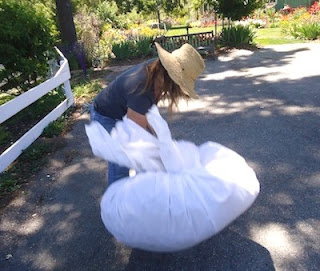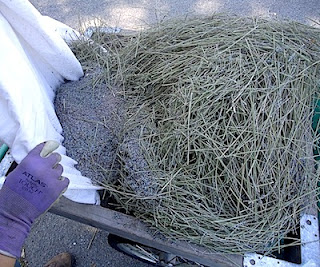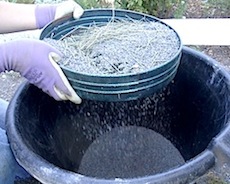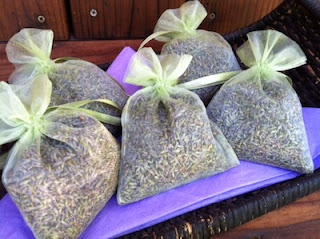by Renee Shepherd and Lindsay Del Carlo
If you love the scent of lavender, you will want to preserve and share your summer harvest of sweet smelling florets. Here are the quick and easy ways we dry our lavender every season to make perfumed dry bouquets and pretty, useful sachets. The following Renee's Garden varieties are
L. angustifolia, the sweet-scented type you can use for crafting:
French Perfume, Hidcote, English Munstead and White Ice. Here is an article about
growing lavenders from seed; be sure to follow the packet directions.
 |
Cut lavender stems roughly from the plant to collect
for making bouquets and to dry the florets for sachets |
Lavender has significant aromatherapy properties that both soothe and relax, so lavender bouquets make welcome gifts that have real functionality. I like to keep several on my car's dashboard and give them an additional squeeze to release the fragrance.
The delicate scent of lavender sachets will gently perfume the cupboards where you keep pillowcases, sheets, blankets and towels, and it also helps repel moths from stored woolens.
The best time to harvest lavender is when the shrubs have come into bloom with ¾ of the florets open on the stems. This is when the aroma of the essential oils is most intense.
Begin by roughly cutting long stems of blossoms from the plants.
Making Dry Lavender Bouquets
Match up the flower heads until you have a nice sized bunch. Pull all of the stems straight and cut them all off at once evenly at the end leaving a long handle.
 |
Match up the flower heads until
a nice big bunch is formed |
 |
Pull the stems straight and cut
them off evenly all at once |
Then fasten a rubber band right below the flower heads, and another one at the bottom of the stems to hold them tightly bunched together so they will dry this way.
 |
Twist a rubber band tightly just below the flower heads and
another an inch or two from the bottom to hold stems tightly |
Now you need to hang the bunches upside down to dry in a cool, shady, airy place. Ordinary coat hangers can hold the bunches while drying: use opened up paper clips as hooks, hooking one end in the bottom rubber band and the other on the hanger.
 |
Hang lavender bunches to dry in a cool, dark place;
a wire hanger and paper clips work great |
They should be quite dry to the touch in about a week. The finished lavender bunches look very pretty wrapped with colored tissue paper and tied with a bow; the tissue paper also helps to catch any florets that drop off. Any time you want to refresh the scent, just give the bouquet a little squeeze.
 |
| Lavender bunches wrapped and ready to give as gifts |
 |
Dry lavender on a sheet in a sunny place,
covering with a sheet for protection |
Making Sachets
To dry the lavender for sachets, scatter the cut stems of bloom (in a single layer as much as possible) onto a sheet in a sunny place like a driveway and put another sheet on top to keep out falling leaves and other debris.
The lavender will take about a week or 10 days to dry fully, depending on how humid your climate is, but check it often and plan to remove as soon as the florets are thoroughly dry, because the essential oils will begin to dry up and lose pungency if left too long.
 |
When the lavender is completely dry, bundle it in the sheet and
smack it on the ground until the florets separate from the stems |
Now this is the fun part; after they are dry, bundle all of the flower heads up into the bottom sheet and smack the bundle on the ground until all of the florets have fallen off of the stems.
 |
Spill all of the lavender, stems and all, into a sifter on top
of a wheelbarrow to separate the stems from the florets |
Then you need to separate the stems. We have made a sifter that is a simple 2x4 wooden frame with a piece of ½ inch hardware mesh stapled to it.
We spill all of the lavender, stems and all, into the sifter and shake it over a wheelbarrow. The dry lavender florets spill into the wheelbarrow and all but the smallest stems stay in the sifter.
Then we use a smaller sifter with 1/4 inch hardware wire mesh to separate out the remaining stems. When the lavender is fully sifted, we collect it in a bag or pillowcase and store it until we are ready to make sachets.
 |
Use a smaller sifter to remove
the remaining small stems |
 |
Sifted lavender is ready to be
sorted for later use |
We put the lavender in decorative sheer nylon bags available at most craft stores or on the Internet (our current source is
www.bagsandbowsonline.com - search for 3" x 4" lavender organdy bags). You can also use the inexpensive but decorative little socks made for babies and toddlers, filling the feet of the socks up with lavender and then stitching under the cuffs to keep them closed.
 |
| Lavender sachets made with decorative bags |
Fill the little bags with loose lavender florets and tie them securely. They make great hostess gifts and stocking stuffers. They are nice to put in lingerie drawers, car glove compartments or anywhere you want that lovely lavender scent.
Final Pruning of the Lavender
After you cut the flower stems roughly from the plants to use for crafts, then you can go back over the plant and fine prune it into a nice, rounded shape. To keep lavender shrubs from getting too leggy, prune the stems to a low point on the older stems where you can see new growth. This helps them to grow back fresh new stems each season and prevents them from developing thick woody bases.
 |
Pruning lavender shrubs to a low point on older branches where
new growth is coming out will help renew its growth each season |





 A perfectly delicious way to enjoy your biggest, juiciest, sun-kissed garden
beauties as a main course; just toss a simple green salad to join them. I always
make a full recipe even if serving just a few friends, because the stuffed
tomatoes are equally good for lunch or dinner the next day, heated up in the
microwave.
A perfectly delicious way to enjoy your biggest, juiciest, sun-kissed garden
beauties as a main course; just toss a simple green salad to join them. I always
make a full recipe even if serving just a few friends, because the stuffed
tomatoes are equally good for lunch or dinner the next day, heated up in the
microwave.
 Mediterranean Spearmint is a vigorous, hardy perennial that will grow happily in a container all year long. Mint plants spread by roots that will eventually fill the container.
Mediterranean Spearmint is a vigorous, hardy perennial that will grow happily in a container all year long. Mint plants spread by roots that will eventually fill the container.